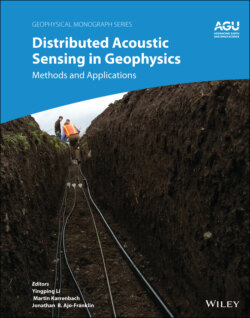Читать книгу Distributed Acoustic Sensing in Geophysics - Группа авторов - Страница 62
3.2.5. Performance of the DMOF‐DAS
ОглавлениеBased on the preceding key techniques, we developed the DMOF‐DAS system as presented in Figure 3.7a, and the DMOF with a microstructure spatial interval of 5 m and a length of 1.44 km was deployed as the sensing fiber for the field test. Intrinsically speaking, the acoustic signal acted as the dynamic strain change on the sensing fiber. To test the acoustic sensitivity and linearity of the DMOF‐DAS system response, a section of 1‐m‐long sensing fiber was wrapped on a cylindrical piezoelectric transducer (PZT), and a strain change with the step of 19.23 nε was applied on the fiber through the PZT. As illustrated in Figure 3.7b, the system exhibited high sensitivities of 0.0153 rad/nε for strain increasing and 0.0152 rad/nε for strain decreasing, as well as an ultrahigh linearity of 1. The slight phase difference between the two curves was only 0.0286 rad, which demonstrated an extremely low hysteresis error. It should be noted that the actual sensitivity of the DMOF‐DAS system with 5 m spatial resolution will be five times that of the tested 1‐m‐long fiber, reaching 0.076 rad/nε. Figure 3.7c shows the power spectral density (PSD) of 1 Hz acoustic signal and the noise floor in static condition for estimating the strain measurement accuracy. It can be deduced that the minimum detectable strain change could be 4 nε/√Hz at 0.01 Hz and 3.4 pε/√Hz at 10 Hz, corresponding to the noise floor of 0.3 rad/√Hz and 2.7 × 10−4 rad/ √ Hz, respectively. These test results demonstrate the ultrahigh sensitivity, especially at the low‐frequency band. Moreover, obvious peak locating at 1440 m, 60 kHz in Figure 3.7d, indicates that the maximum frequency of the acoustic signal can reach up to 60 kHz.
Figure 3.7 Sensing performance of the DMOF‐DAS system: (a) Photograph of the equipment; (b) strain sensitivities and hysteresis for the strain increasing and decreasing processes; (c) noise PSD of phase change on two sections of the fiber with 1 Hz dynamic strain change and static strain change, respectively; and (d) frequency spectrum along the 1.44‐km‐long fiber when the dynamic strain change at a frequency of 60 kHz is applied on the fiber.
